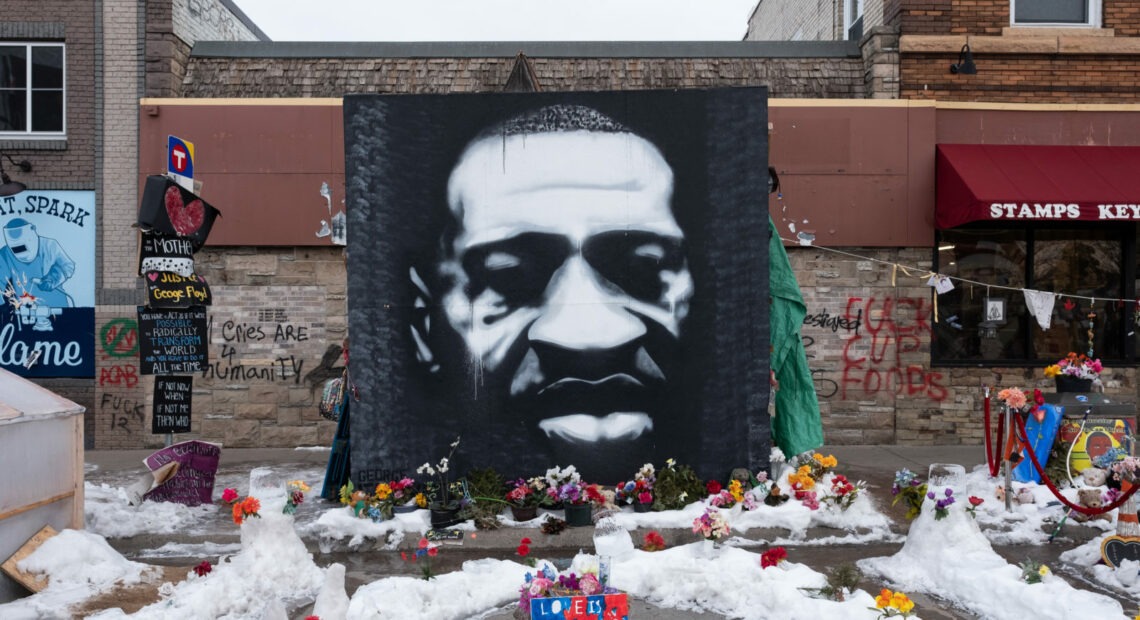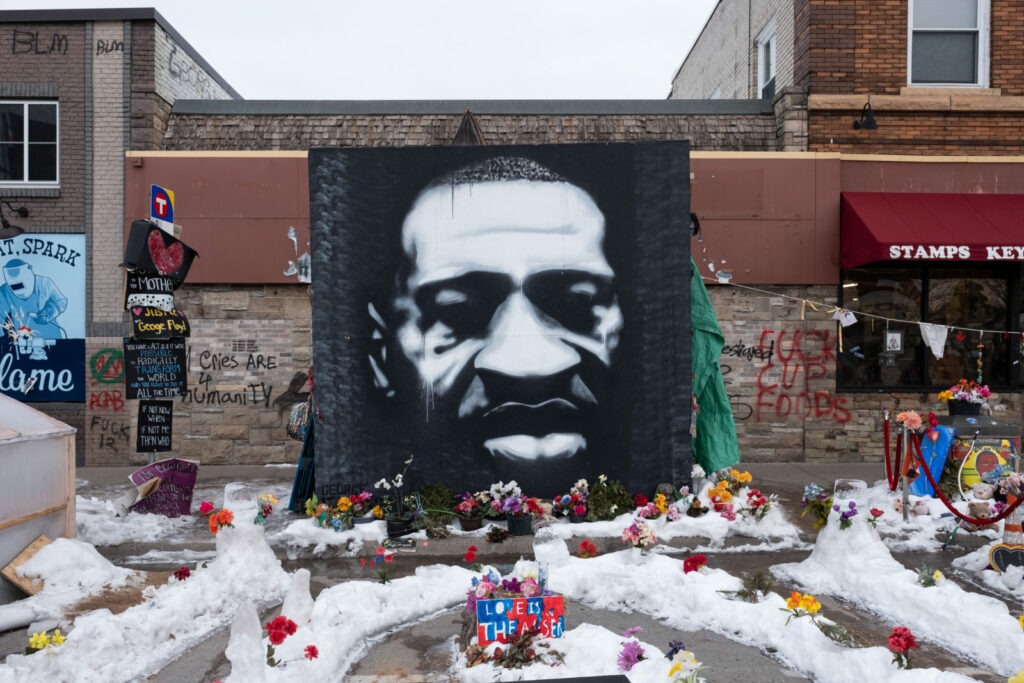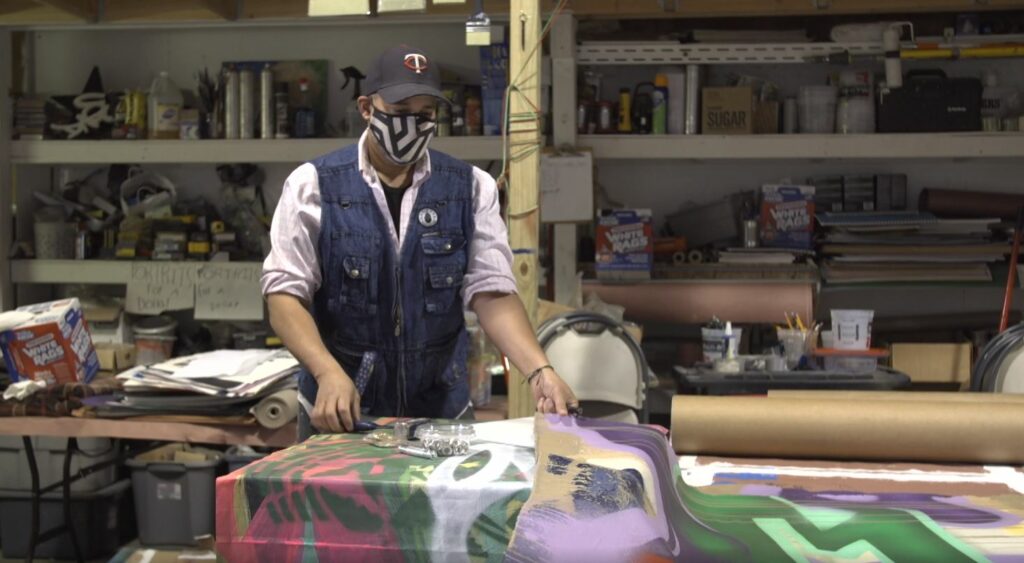
The Artist Behind A George Floyd Mural Reflects On How It Became A ‘Ubiquitous Icon’
BY SAM LANE, FRED DE SAM LAZARO & DOROTHY HASTINGS / PBS NewsHour
In the year since George Floyd’s killing, artists nationwide have covered walls, streets and plywood with images and messages calling for racial justice.
In Minneapolis, where Derek Chauvin fatally knelt on Floyd’s neck for more than nine minutes, Floyd’s face and name are practically omnipresent – spray painted on buildings and etched into sidewalks.
One of the most recognizable images of Floyd sits just above the spot where he drew his last breath – at the corner of 38th Street and Chicago Avenue in South Minneapolis. It’s a haunting, 12-foot mural of Floyd, painted in black and white by Minneapolis-based artist Peyton Scott Russell.
Russell grew up just steps from the intersection where Floyd was killed. Russell said he felt angry and lonely in the days after cellphone video of the death made its way around the world – and saw his own father’s face in Floyd. He was compelled to protest in the streets, a feeling he said he’d never had before.

A mural of George Floyd at the intersection of 38th Street and Chicago Avenue S. in Minneapolis, United States, on January 18, 2021. CREDIT: Tim Evans/NurPhoto via Getty Images
But Russell then realized he had a more powerful tool: his “voice” as a graffiti artist.
Russell originally planned to install the mural at night, anonymously, and “paint Mr. Floyd’s face as large as I could, as a way to say, ‘Look what you did.’” He wanted the mural to be intrusive, an “obstacle” you couldn’t easily avoid. Ultimately, Russell brought the mural to George Floyd Square during the day and a team of people helped him install it on a bus shelter.
“As an artist, I appreciate and really respect the recognition that I’ve gotten for the piece,” said Russell, who runs a graffiti art education program in Minneapolis called SPRAYFINGER. “Every artist wants a degree of recognition for what we make … I feel proud that I was able to contribute to the protest of what had happened and to express my feelings about what happened.”
But Russell acknowledged feeling “a little weird” about getting fame and recognition from work related to the tragic event.
The PBS NewsHour’s Fred de Sam Lazaro spoke with Russell about his work, the attention it’s gotten, and the role of art in a year of protest.
This interview has been edited for length and clarity.
Your mural began as a personal expression of your reaction to what had happened on May 25. Share that journey with us. What did you try to do?
I was incredibly moved [when I watched the video of George Floyd’s killing]. First of all, I found out that it was in my old childhood neighborhood and the corner that I grew up on — 38th and Chicago. I had a visceral connection to that area and especially Cup Foods [the corner market]. The other thing was — my father is a very dark-skinned Black man, and I just kept seeing my father’s face on George’s face. So those connections — I was just really tying all that together. In that moment, I thought I was alone in how I felt, the anger that I felt in that moment. I wanted to go out and physically protest, which I had never felt like that ever in any of these circumstances that have happened before to the other tragedies under police custody. It was a reaction that just blew up in me.
I vented to some of my elders, people that were close to me, and they were calming me down. And then I had a few people tell me that I had a stronger voice than to go out and physically protest, which is my art voice as a street artist and graffiti artist. I wanted to take this moment to cast a light on this current situation. As I was sitting in the studio contemplating what I was going to do, a friend of mine called me up and said, “Hey, I think we need to put some action on what happened.”
I hadn’t spoken to him in probably a couple of years. He said, “Hey, I think we should do [a giant] billboard.” I think that’s perfect. He asked me what I needed. I kind of arbitrarily said, “Let’s do a 12 by 12 square.” The next morning, he pulls up with a flatbed with all this lumber. He spent a couple hours cutting the wood and making the canvas, this 12 by 12 plywood surface. We bring it into my studio, and I spent the night painting this image, a couple of nights after the curfew had been implemented.
My original thought was I was going to install this at night as an act of street art, anonymously, and paint Mr. Floyd’s face as large as I could as a way to say, “Look what you did.” Just put it somewhere that was just really intrusive as an obstacle. It was incredibly heavy. I needed help. I needed a way to transport it. And the next day, some of my studio mates were walking back and forth, and didn’t know how we were going to transport it. Some people just kind of popped up and said, “Hey, I’ve got a truck. We can secure it to the back. We can carry it over.”
I’m not a religious person but there was definitely something else guiding this process. From the moment of thinking about what I wanted to do, to someone calling me, helping me with the idea of what to do, and then where we were going to install [the mural]. I never knew the next move. I just kind of went on passion and faith, and every move was perfect along the way. It just became this ubiquitous icon that is now identifying that corner, the incident.
How does that make you feel?
As an artist, I appreciate and really respect the recognition that I’ve gotten for the piece. I mean, every artist wants a degree of recognition for what we make. I’m not shaking a finger at that at all. I just wish it was under different circumstances. I feel proud that I was able to contribute to the protest of what had happened and to express my feelings about what happened. And I feel a little weird about getting the fame and the recognition based on the tragic event.
So I have mixed feelings about it. I’m trying to redirect that energy into my student art program. My program, SPRAYFINGER, is about teaching folks the artistic merits of street art and graffiti, and the benefits that it has to society, rather than the detriment that people consider graffiti a piece of vandalism. It’s kind of fitting that I created a piece of street art that has got this international attention. And then I can redirect some of that attention into my program and students and talk about the importance of street art and how it can be used as a tool for understanding, comfort, bringing people together on common ground, and just using environment and resources to make a statement.

Artist Peyton Scott Russell prepares a canvas painting at his studio in Minneapolis. CREDIT: Sam Lane/PBS NewsHour
Can you talk a little bit about the piece itself? What do you think touches people in a way that it clearly does?
I’ve had some personal experiences with police brutality, and I think some of that energy went into this painting. One of the curriculums that I have in my program are the face stencils. It ended up being the most popular. It’s the most satisfying process to take a photograph, turn it into a high contrast image — project it, trace it and then cut the shadow or the darker images out and then spray paint them on a wall, a canvas, another surface. It’s just a really fun process to create a stencil. And I immediately was like, “OK, as an act of street art, I’m going to create a stencil, if you will, of Mr. Floyd’s face and then recreate that.” And so I need a picture of him. And right away that selfie that’s so famous now that he took of himself, I used that. And then I did what I normally do. I high contrasted it, and I superimposed it, brought up some of the shadows of it, and it just felt right.

A man sits on a bench in front of Peyton Scott Russell’s George Floyd mural at George Floyd Square in Minneapolis. Photo by Kerem Yucel/AFP/AFP via Getty Images
As I was working, I had very emotional moments. Again, the curfew had just been implemented. Our city was smoldering. And I’m in my studio painting this picture, and there were times that I was weeping [while] painting the picture, and I had to take breaks. Seeing that face, that large, and painting it that way with that black and white, was really profound to me. There are parts of it that are classic techniques in graffiti art, working with dripping and superimposing images and dusting, and things of that nature that are done with spray paint. I wanted to create some movement. Some of that energy was dripping effects. I was trying to find areas where that would look good. So I let some of the paint drip. One thing that took a hold was the drip area in the eye. Now, that was not intentional as far as putting it into the location where the eye was to make it look like a tear. That wasn’t what I was doing. I was finding areas in the piece to create movement and it just so happened to be just under the eye in the shadow of the cheek where the drip is, and then it turned into like this tear.
It was one of the first pieces that I created strictly off of emotion and in the moment. I didn’t have a whole lot of time to think about how I was going to do it, what I was going to do, where it was going to go. Things just came as they came. I spent the night in the studio painting it. Because of a curfew, I couldn’t leave my studio to go home. I didn’t want to get pulled over, in the middle of the night. I just stayed in the studio and painted it overnight and kind of pushed through. It’s honestly really a blur. It just came out of me.
What do other people tell you about that picture and its impact on them?
I stand there and I watch people take selfies and groups of people, people come from out of town to go to that intersection and to take photographs. I’ve seen that picture pop up in all kinds of publications. I’ve been contacted to give permission to use that piece in a number of backgrounds and stories. I’ve been really careful about, “Am I really, morally, that person to say yes or no, who can use this and who can’t?” I painted it for the community and I needed to let it go and let the community own it. And that’s what street art is all about.
Now, it has fallen back in my lap just because of the popularity and the recognition that I’m the artist who created it and people have come to me again for permission to use it in interviews and backdrops and videos and posters and et cetera, et cetera, et cetera.
They want to license it essentially.
Correct. They want me to sign off permission for the use of the image rights. And this is actually the first time I’ve ever had to think about this. I’ve been really careful of who I give permission with. I’ve been in contact with the Floyd family. And I’ve been really transparent with them about these situations.
I’ve lived my entire life as a struggling artist, and here’s an opportunity, as tragic as it is, where I can have some sort of monetary benefits for this, but I needed to have permission from the family. I needed to have their blessing to do anything like that, as well as making sure that they also benefit from anything like that. So I reached out to them, and we had a great conversation. And they loved my idea. And so we’re moving forward with creating a smaller piece that anyone can purchase. I am going to recreate a smaller print, screen printed, pulled by hand.
I want people to own a piece of this so they can have a piece of this historical moment to be able to look back to say that they got a little ownership of this icon that represented this moment in time. That was one of the reasons why I reached out to the family to create this piece so that people can actually own a little piece of this. And again, being an artist, I feel blessed and happy that I can contribute in that way to some sort of historical document, some sort of historical artifact that now you can have and say, ‘I was there. I got this particular piece and this is what this represented, this particular face.’
We’re coming on to a significant, profoundly important moment, in the history of the city: the anniversary of Floyd’s death. Do you see a role for art in all of this as the city approaches this?
Art is the first mode of contact. It’s a source of comfort or peace of understanding. People look towards artists in all kinds of situations to explain what happened. And I think everybody has had an opportunity to see that in real time, especially with a lot of the street artists and graffiti artists having more of an open canvas and more of a permissioned, sanctioned canvas of the city to express these emotions. I think people have gotten a different understanding of what street art can do when it’s used in a positive way.
Copyright 2021 PBS NewsHour. To see more, visit pbs.org/newshour















